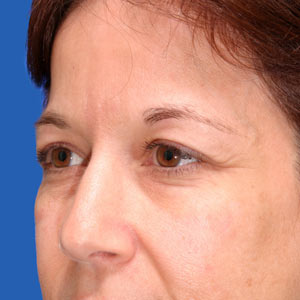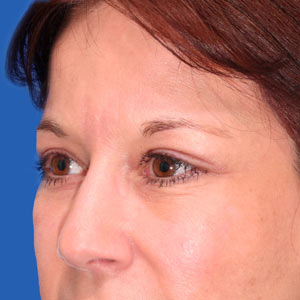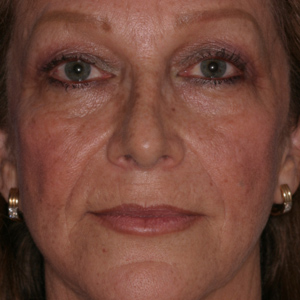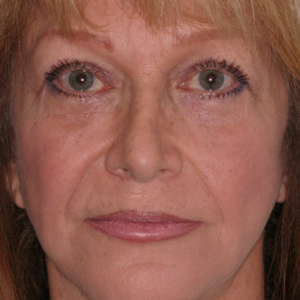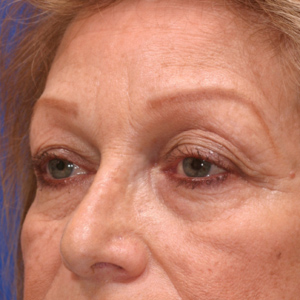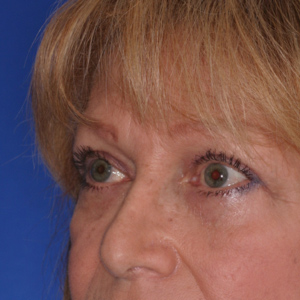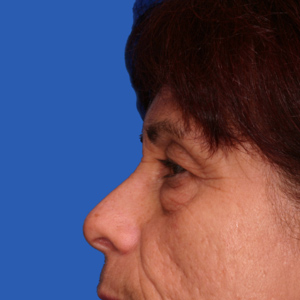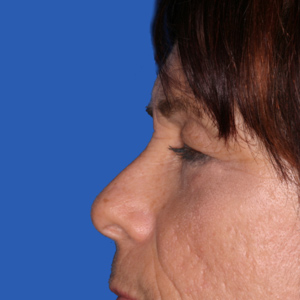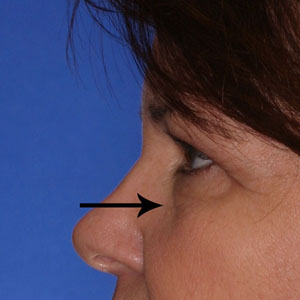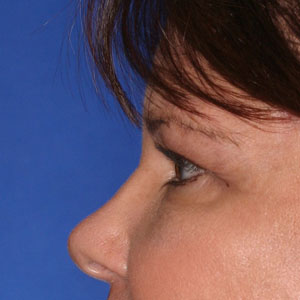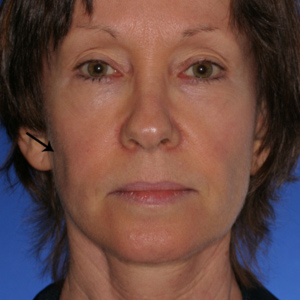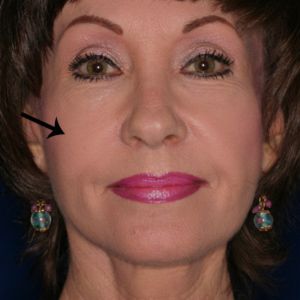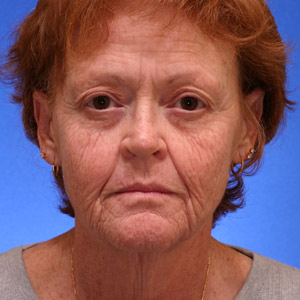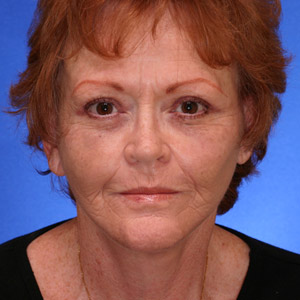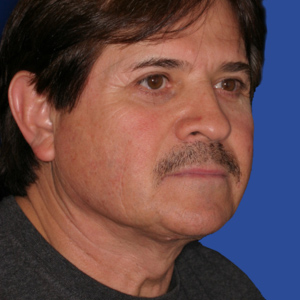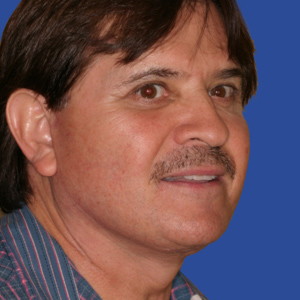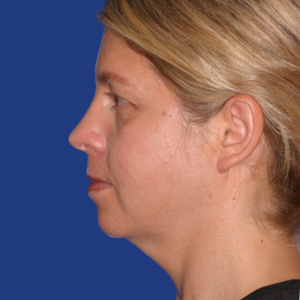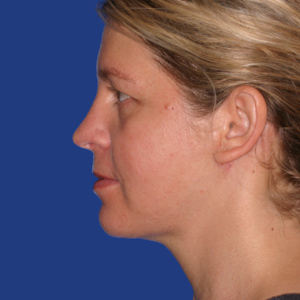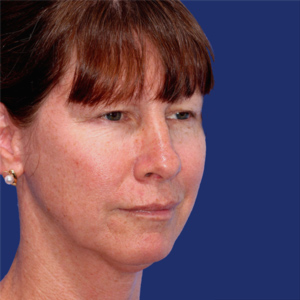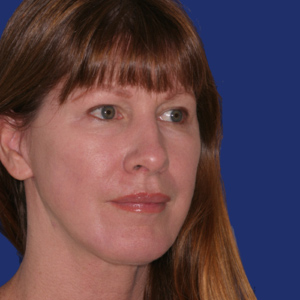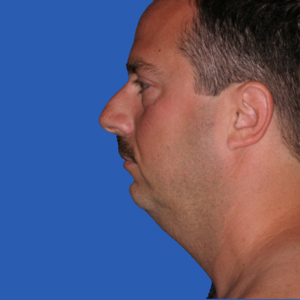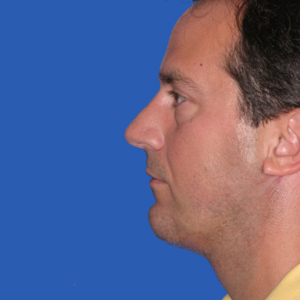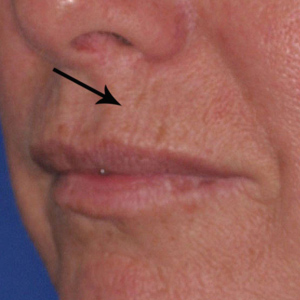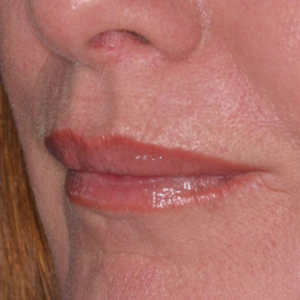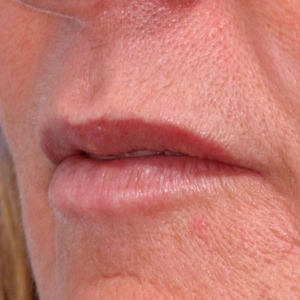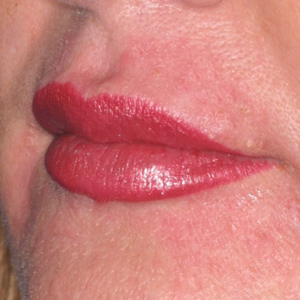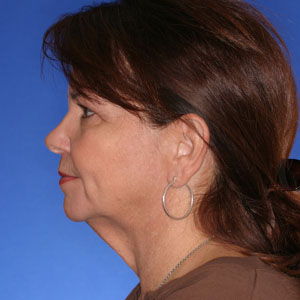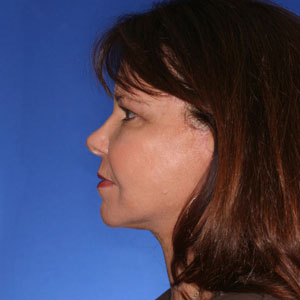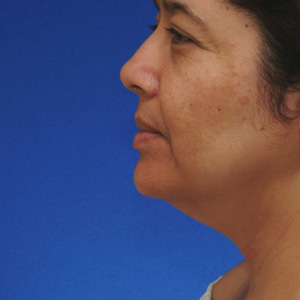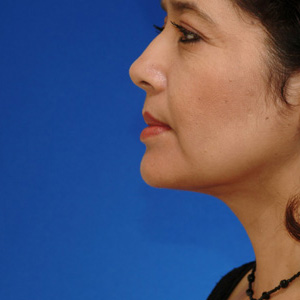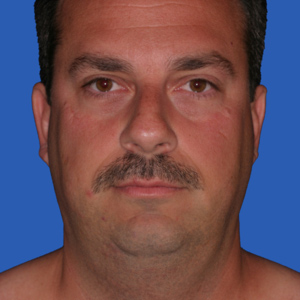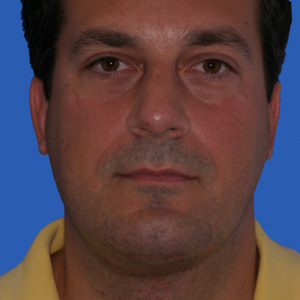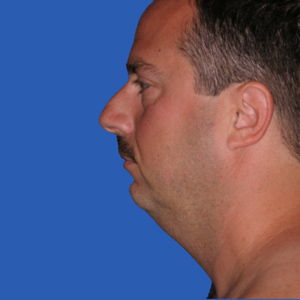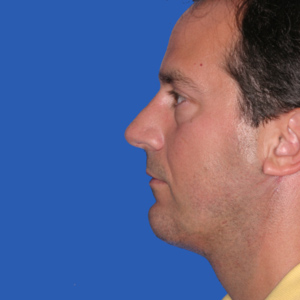Joseph T Cruise, MD's Face Lift Philosophy
Joseph T Cruise, MD's Facelift Philosophy Explained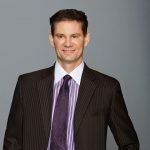
The world of face lifting has undergone dramatic improvement over the last ten years. In my hands, it has become less focused on skin-tightening and more focused on the resuspension and addition of fat with gentle re-draping of the skin. This eliminates the over-done "surgical look" and creates a natural, youthful appearance. The difference between "surgical-look" of the traditional face lifting and the natural look of the new Custom Lift® is apparent in the pictures.
Custom Lift®
After reading the previous sections, you already understand that facial aging is actually a very complex process. It primarily involves the descent and loss of facial fat and muscles and secondarily the stretching of the skin. This is why I adamantly believe it is critical to address each patient's specific problem areas instead of performing a one-size-fits-all lift. Extensive face lifting experience has led me to develop the Custom Lift®. The Custom Lift® is a methodical way of identifying the individual causes of each patients facial aging and applying the least invasive correction method possible. This obtains predictable results with minimal down time. It corrects the underlying problem instead of creating a "pulled" look.
The real value of the Custom Lift® is in the experience and methodical thought process Joseph T Cruise, MD. Rather than a 'one size fits all' procedure created by a plastic surgeon marketing team, the Custom Lift® is unique for each individual and performed by highly experienced Board Certified Plastic Surgeon, Dr. Joseph Cruise. He has built his/her own practice based on great results and patient referrals.
What exactly is a Custom Lift®?
There are three fundamental processes that make the Custom Lift® so predictable and successful.
Clearly Identify the Primary Concern. A proper consultation with a board certified plastic surgeon will accomplish this task. Common concerns include:
- a tired appearance of their eyes,
- a gaunt, hollow look of their cheeks,
- sagging jowls,
- hanging neck.
It is critical to understand what it is that bothers the patient the most to make sure that, at a minimum, this concern is corrected.
Identify the Contributing Factors. Custom Lift® categorizes this as the "Regional Approach" to facial rejuvenation. Facial aging is not an isolated process. It involves entire areas. This is sometimes a difficult concept to understand but it makes sense. A great example is the tired upper eyelid. Patients routinely believe that just removing the upper eyelid skin will take care of their problem. This is rarely the case, especially in people over 40 years of age. Often, there is a sad look to the outer part of the eye caused by descent of the temple region. This gives a "hooded" appearance to the outer corner. This responds exceptionally well to both a temple lift and an upper blepharoplasty because this addresses all the contributing problems to this area. Conveniently, adding the temple lift does not significantly increase the down time or cost of the procedure.
Upper Eyelid, Temple Lift and Unilateral Brow Lift on the Right.
A more complex example is what occurs with aging with the face and neck. There are always multiple contributing factors. It is the plastic surgeon's responsibility to determine what they are based on his/her extensive experience and training. Later in this section we will break down each area into components. This is the methodology that is used by plastic surgeons who perform the Custom Lift®. Breaking down each area will allow you to easily understand what is causing your area of concern.
Prioritize. Simply telling you what needs to be corrected is not enough. It is critical for your surgeon to accurately assess what is the relative importance of each contributing factor and to prioritize them. This allows you to make an educated decision as to what is necessary to achieve the results you are looking for. You can make an educated decision regarding how much or how little you want done. A one-size-fits-all face lift is never appropriate.
- Identify the primary concern
- Identify the contributing factors
- Prioritize
The fundamental concept of the Custom Lift® is to educate each patient in an easy to understand fashion the causes of their facial aging. Then, to prioritize the treatment plan so that the patients can achieve their desired result in the least invasive manner possible.
Obtaining the Best Result Possible is Paramount. Other heavily marketed face lifts concentrate on a "one size fits all" factory-type face lift. Whereas, Custom Lift® represents the best that plastic surgery has to offer.
To enhance the results certain ancillary procedures such as a fat transfer, chemical peel, Botox®, etc can be added. This allows for a complete rejuvenation.
Face lift enhanced by Chemical Peel and conservative Lip Augmentation.
Components of the Custom Lift®
The Custom Lift® evaluates facial aging by dividing the face into four anatomically linked regions; the upper face, the midface, the lower face, and the neck. This regional approach allows one to understand all the components of aging within that area. It should be mentioned that the entire face ages with time, however, some areas may age more dramatically.
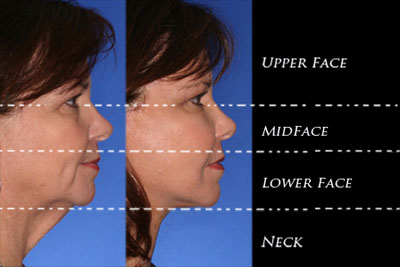
Often, it is critical to address multiple components within the problem area in order to obtain an optimal natural rejuvenation. In keeping with the Custom Lift® philosophy, it is critical for you to understand the relative importance of each component. This allows you to obtain the desired results with the least invasive approach. Let's go through each region.
Upper Face Rejuvenation
Approach to the problem areas of the Upper Face.
Below, we have listed the six most common concerns regarding the upper face. Remember, the entire concept of Custom Lift® is to identify which of these issues are of concern to you AND the relative importance of each concern. With this information, you can then intelligently outline which procedures are best suited for you. Unfortunately, with time everyone will experience aging to ALL six areas but this does not mean that each must be addressed at the same time.
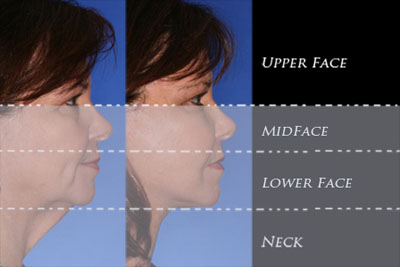
1) Upper Eyelid.
The most common problem with the upper eyelid is excess skin. Fat excess is rarely a problem except in the Asian community. In fact, the upper eyelid area LOSSES fat with age and becomes hollow and gaunt. Sometimes, there is a little bulging fat pad right next to the nose but aside from this all fat in the eyelid is precious and should be preserved. If you have this fat pad it is located just above the corner of the eye near the bridge of the nose. This should be removed at the time of upper blepharoplasty.
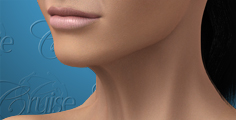
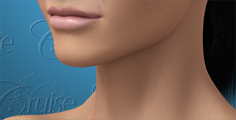
Animated Upper Eyelid Surgery
Scroll over the image to see the effects of a skin removal from the upper eyelid. Notice how the crease is more defined and the eyes look more rested.
What does the Upper Blepharoplasty do?
Custom Lift®'s approach to upper blepharoplasty is to remove the excess skin to define the upper eyelid and give it a youthful appearance. In women, this means creating an elegant, defined upper eyelid. This allows makeup to go on easily without smudging. The size of the upper eyelid is up to the patient. Men require a less dramatic result. They do not tolerate an "operated on" appearance.
How do I know if an Upper Blepharoplasty will help me?
If the skin of the upper eye lid hangs down over the eye lid you would benefit from an upper blepharoplasty. Typically, this excess skin is easily pinched and feels "paper" thin.
Patient with significant excess skin and hollowing of the upper eyelid. Notice how rejuvenated the post-operative picture looks, without an "operated" appearance.
2) Temple Region, Crow's Feet, and Outside Corner of the Eye
This is the area of the upper face that ages the quickest. Yet, it is often not addressed by most plastic surgeons. The temple region is the outer corner of the eye and the outer part of the eye brow. Typically, lifting the temple with a Temple Lift creates dramatic improvement in appearance. The nice thing about the temple lift is it can easily be done under local anesthesia with or without a blepharoplasty.
Notice tired and hooded appearance of outer part of the eye and eyebrow. Notice the bright and elegant appearance after temple lift and upper blepharoplasty.
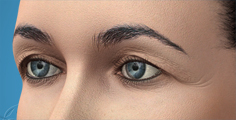
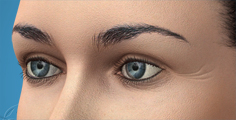
Animated Temple Lift
Scroll over the image to see the effects of a temple lift. Notice rejuvenaion of outer brow, outer corner of the eye and crow's feet.
What does the Temple Lift do?
The temple lift does several very important things in terms of rejuvenating the upper face. It lifts the outer corner of the eye. This dramatically improves the hooding of the outer eye that often makes you look sad even when you are not. It raises the outer part of the eye brow creating a very elegant look. In fact, it can often replace a brow lift completely. Finally, it removes the crow's feet that are caused by excess skin.
Correction of crow's feet with upper eyelid surgery and temple lift.
How do I know if a Temple Lift would help me?
The best way to see if a temple lift would benefit you is to elevate your temple and see if you like the look. Simply, place the finger tips of your index, middle, and ring finger right at the hairline of your temple and elevate it gently; not too much because this will over correct. Chances are this will dramatically create a more youthful, elegant appearance.
Using the Custom Lift® approach, Joseph T Cruise, MD routinely performs both an upper blepharoplasty and a temple lift at the same time. This rejuvenates the entire upper face. Best of all, both can be easily done under local anesthesia without pain.
3) Brow Position
With aging and loss of facial volume, the brow routinely drops down. Sagging of the brow is almost never uniform. The outer part of the brow almost always sags more than the inner part. See if this applies to you. If only the outer part of the eye brow has fallen (which is often the case) then a temple lift is the best choice for correction.
If the entire brow has fallen, then a brow lift may be necessary. I say "may" because the Custom Lift® approach prefers to correct the problem at its cause. Often the brow falls because the upper eyelid/brow area has lost significant fat.
Example of one sided brow sag. Right brow corrected with brow lift.
The loss of fat volume causes the brow to descend and the upper eye to look hollow. The best way to correct this is to perform a temple lift to raise the outer brow and to replenish the lost volume with either fat or a soft tissue filler.
By correcting the cause of the problem, facial rejuvenation looks much more natural.
What does a Brow Lift do?
A brow lift elevates both the inner and outer part of the brow. The temple lift elevates only the outer part of the brow.
How do I know if a Brow Lift will help me?
It is far more likely that you will need a temple lift. The real question in the CustomLift® approach is whether or not you need a brow lift in addition. You can check this by first imitating a temple lift as described above. If the central part of the brow still seems low than a brow lift is most likely necessary.
As you can tell, I am much less enthusiastic about the brow lift than I am about the temple lift. This goes back to the Custom Lift® principles. The temple area and outer brow fall much earlier and more significantly than the central and nasal part of the brow does. Therefore, this is the area that should be addressed first. There are too many people walking around with an unnatural "surprised" appearance to their brow because their surgeon did not address the problem at its cause.
By correcting the cause of the problem, facial rejuvenation looks much more natural.
4) Sunken, Hollow Appearance of Upper Eyelid
This area is a perfect continuation of the brow area. As mentioned above, the brow often falls because the brow area and upper eyelid losses fat with age. Not only does this drop the brow but it causes the upper eyelid to appear sunken and hollow.

Young hollow looking eyelids that would benefit from extra volume.

The same eyes as above but filled in with soft tissue filler to give it more youthful, fuller look.
Soft Tissue Filler correcting hollow upper eyelid. Notice the dramatic natural rejuvenation.
Traditional plastic surgery principles would treat this problem with a tight upper blepharoplasty and a brow lift. This often leads to a hollow, surprised appearance that actually looks unnatural. CustomLift® principles treat this problem by replacing the lost volume with a soft tissue filler or fat which, after all, is the root cause.
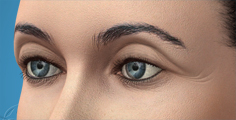
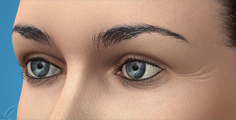
Animated Fat Transfer to Upper Eyelid
Scroll over the image to see the effects of a fat transfer to upper eyelid. Notice how the fat replenishes lost volume necessary for a youthful appearance.
What are soft tissue fillers?
Soft tissue fillers are a myriad of injectable substances that add volume.There are two distinctly different types. One type comes packaged and ready to inject. You probably have heard of them by name, i.e. Restylane®, Juvéderm™ , Radiesse, etc. The other type is your own fat. Obviously, this needs to be removed from elsewhere on your body, purified, and then re-injected. The clear advantage of the packaged soft tissue fillers is that it does not require a donor site and is much simpler with less down time. The advantage of fat is that it lasts forever.
How do I know if I need a soft tissue filler for the upper eyelid?
This is best done by first simulating a temple lift with your index, middle and ring fingers.
Now, look at the upper eye lid. Is it hollow? Does it look sunken? If so, a soft tissue filler will help immensely. The good news is that it is relatively quick with little to no down time. A huge advantage of the packaged soft tissue fillers for the upper eye lid is that they last much longer than they do in the lips or naso-labial folds. They can last up to two years.


Static Crow's Feet corrected with Temple LiftExample of face at rest and dynamic wrinkles. Those can be best addressed with BOTOX®. The results from Botox® can be amazing and has essentially no down time. The obvious draw back is that it only lasts 4 to 5 months.
6) Sun Damage and Poor Skin Quality
With age and sun damage many unfavorable things happen to facial skin. The surgical procedures above address how to manage excess skin, skin sag, volume loss, etc. The most difficult problem to correct is poor skin quality.
Aging causes the dermis to thin. This, along with sun damage, causes the skin to loose its elasticity. Therefore, neck skin that would snap back in a 30 year old becomes saggy skin in a 50 year old.
How can the skin quality be improved?
The Custom Lift® addresses poor skin quality with two modalities. One is a TCA chemical peel. This penetrates the dermis causing it to heal with thicker and more elastic dermis. It has anywhere from a 3 day to a 2 week recovery period depending on how strong of peel is desired. The most impressive result of a chemical peel is how it gets rid of the aged spots caused by sun damage.
Sun damage corrected with chemical peel. Notice the dramatic improvement of skin quality.
The second modality is routine exfoliation and dermal thickening. This is done with a glycolic acid moisturizer in the morning and retinoic acid (Retin A) at night. Both of these agents are excellent exfoliators. They get rid of the top layer of dead skin and leave a healthier, radiant appearance. They are inexpensive and effective, unlike many highly marketed products which really do not work. Other modalities can also be incorporated but these two are essential.
Putting it all together: How to decide which procedures are right for you.
Remember, the entire concept of the Custom Lift® is to define the problem areas and to prioritize what needs to be done in your custom face lift. This is where your plastic surgeon's experience is critical.
The most common surgical combination I do for the upper face is the upper blepharoplasty with temple lift. These two go hand in hand especially for most people in their forties and above. The nice thing about this combination is they can easily be done under local anesthesia with minimal recovery. So, from the CustomLift® point of view, the upper blepharoplasty with temple lift is a "Home Run." It has predictably good results, minimal down time, and is relatively low cost.
Mid Face Rejuvenation
The Custom Lift® approach to the problem areas of the Mid Face.
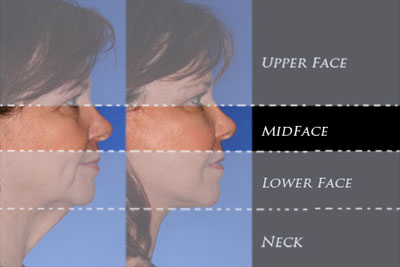
1) Lower Eyelid
The lower eye lid is the most complex area of the face when it comes to the aging process. Only recently has plastic surgery begun to understand what really is causing the aging appearance here and even more recently have we figured out how to treat it.
The biggest culprits of lower eye lid aging include:
- excess skin
- sagging of the outer corner of the eye lid (crow's feet)
- bulging eye lid fat (bags)
- circles under the eyes
All of these problems are caused by different aspects of the aging process. The key is to identify which ones are your major concerns, prioritize them, and address them in methodical fashion.
Before we go into the individual aspects of the lower lid, I want to comment on the profound effect fat loss has on the cheeks and lower eyelid. It is probably the single biggest contributor to the aged look of the lower lid and mid face, yet, only recently have we begun to understand this. Because of its attention to detail, Custom Lift® has been at the forefront of recognizing this extremely common problem.
Fat transfer to the cheeks and lower lids has become one of the most common procedures I perform on the face. Replenishing volume is treating the problem at its root.
Excess Skin of the Lower Lid
Excess skin of the upper eyelid occurs early in the aging process. The lower lid, however, is different. The skin laxity becomes a problem typically later in the aging process. Fat loss routinely precedes skin laxity. Excess skin shows itself as wrinkly, redundant skin over the lower lid. Often, it can be pinched and pulled away from the lid once it becomes significant.
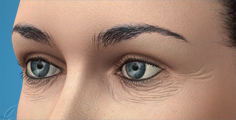
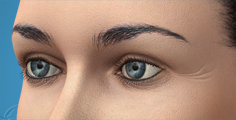
Animated Lower Eyelid Skin Removal
Scroll over the image to see the effects of lower eyelid skin removal.
Correction of wrinkly lower eyelid skin with skin removal and temple lift.
Excess skin of the upper cheek/crow's feet; tired appearance
Conventional plastic surgery techniques typically treat this problem with skin and muscle removal. The Custom Lift® treats this by performing a temple lift with or without skin removal of the lower eyelid. This elevates the saggy skin all the way down to the upper cheeks and crow's feet area. This does many positive things. It gets rid of the crow's feet as well as the excess skin of the outer part of the lower lid. In addition, it creates a bright, elegant appearance.
As you may have noticed, I have placed the temple lift as treatment for both the upper and lower eye lid. This is because the temple lift has a powerful rejuvenating effect on entire eye region. Aging of the temple region is responsible for much of what we have come to recognize as aging around the eye.
The temple lift is perhaps the most powerful rejuvenating procedure related to the eye.
Bags under the eyes
Bulging (Bags) of the lower eye lid is caused by two completely different processes. The first one is the most obvious; bulging fat of the lower lid. This fat swells more in the morning and when you are sleep deprived.
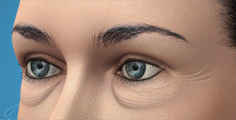
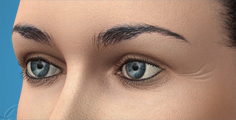
Animated Removal of Bags under the Eyes
Scroll over the image to see the effects of removal of bags.
Example of removing lower eyelid fat, otherwise known as "bags."
The Custom Lift® evaluates which of these two factors is present and which needs to be corrected. It is not uncommon to remove fat from the lower lid AND replace fat to the cheeks. This directly treats both issues and, thus, is the most effective treatment for lower lid aging.
2) Hollow Cheeks and Circles Under the Eyelids
All humans begin losing fat in their cheeks starting from the day they are born. Losing fat before the age of 16 is called "losing baby fat." Losing this same facial fat above the age of 30 is called "aging."
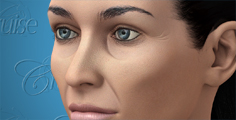
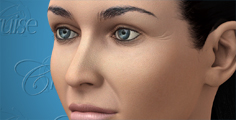
Animated Fat Transfer to Cheeks and Lower Lids
Scroll over the image to see Fat Transfer to Cheeks and Lower Lids
At 20, this aging is attractive because it sculpts and defines the face; especially the lower cheeks and jaw line. Once we get over 30 our fat reserves are gone and aging sets in.
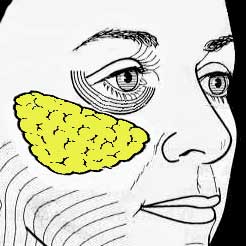
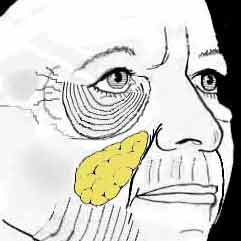
- Youthful Face - Cheek fat is just below the eyes.
- Aging Face - Cheek fat has descended and diminished in volume.
This fat loss becomes a problem in women at the age of 30 and with men at the age of 40. This is because a more defined look is desirable in men whereas, in women, it is considered a sign of aging.
The significance of cheek fat loss has only recently come to our attention. This is perhaps the single biggest cause of what we perceive as facial aging.

Youthful cheeks with a lot of facial fat.
Look at anyone over the age of 50. By this age most of the cheek fat has gone away leaving behind a hollow, gaunt appearance. Loss of cheek fat over the upper cheek bone leaves the characteristic circles under the eyes. The only way to treat this problem is to replace the fat, thus, restoring our fat reserves.
What does Fat Transfer do?
There are several aspects of fat transfer that make it extremely appealing.
- First and foremost, is that it replaces the precious fat of the cheeks creating a youthful appearance that can not be obtained by any other method.
- It takes fat from an area that usually has too much, i.e. the abdomen creating a win-win situation. Unfortunately, with age we gain fat in the areas we don't want it and lose it in the areas where we need it most.
- It can easily be done under local anesthesia, thus, making it more cost effective and convenient.
Finally, the amount of fat transferred is controllable as the procedure can be repeated until the desired result is obtained. Adding fat not only replaces the fat you have already lost, it gives you a buffer so that when you lose fat in the future it is not so noticeable.
Fat transfer to cheeks. Notice how effectively it rejuvenates the hollow, gaunt appearance of the face and how natural it looks.
3) Naso-labial Folds
The Custom Lift® approach to the naso-labial folds, aka "parenthesis deformity," is quite different than the current standard treatment. The mainstay of current treatment is injecting a soft tissue filler to plump up the crease. This does not treat the root cause of the problem.
These folds are not caused by the crease getting deeper. It is caused by the fold above the crease hanging down. Therefore, filling in the crease does not make sense. In addition, this soft tissue filler rarely improves the look for more than two months.
The fold above begins to hang because of loss of cheek fat. Once the volume of the cheek is decreased the skin begins to hang. Therefore, CustomLift's long term treatment to the problem is to add fat. This will improve the hanging folds by inflating the cheeks.
By correcting the cause of the problem, facial rejuvenation looks much more natural.
Lower Face Rejuvenation
The Custom Lift® approach to the problem areas of the Mid Face.
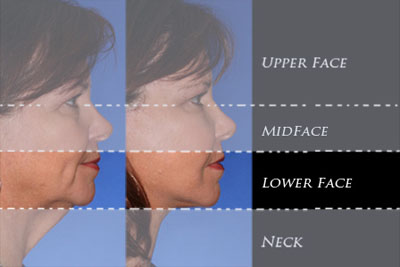
1) Jowls, Jaw line, and Marionette Lines
Jowls, marionette lines, and poor jaw line definition are routinely treated by a face lift. Let's go over the causes of these problems so we can better understand the treatment.
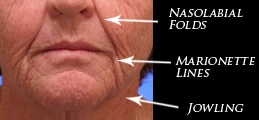
Marionette lines are the lines that form at the corner of the mouth and go downward. 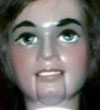
They may look like an extension of the naso-labial folds but they are treated differently. The root cause of jowling, marionette lines, and poor jaw line definition is the same. It is a combination of saggy facial skin, descended facial fat, and loss of facial fat.
Optimum correction of these three issues requires correcting each of the three underlying problems during your face lift process. Having said that, you may choose to obtain partial correction by undergoing a more conservative procedure. This is what the Lifestyle Lift™ offers.
Lifestyle Lift™ performs a basic face lift under local anesthesia correcting the skin excess. Custom Lift® offers this one dimensional procedure as well to select patients who do not need much fat elevation and replacement. This is rare. In addition, Lifestyle Lift™ does not routinely directly address the neck problems which is often the biggest problem. Still, in the right patient, the Lifestyle Lift™ can obtain good results but it is limited.
If all you need is skin tightening than a mini face lift under local anesthesia may be a good option. This is the least invasive of the options offered by Custom Lift®. As mentioned above, facial aging is rarely just a skin problem.
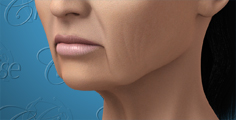
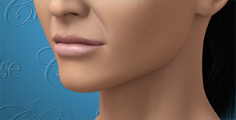
Animated Correction of Lower Face
Scroll over the image to see the effects of face lift on the jaw line, marionette lines and down turned corners of the mouth.
The Custom Lift® is not a procedure. It is a methodical plan to identify all the aspects of facial aging and choose which procedure is necessary to obtain the result you are looking for.
Correction of jowls, marionette lines and poor jaw line definition with face lift. Notice the youthful triangular appearance of the lower face.
Fat elevation and fat transfer is an integral part of the Custom Lift® when there is jowling and hollow cheeks. Fat suspension will elevate the jowl fat so that it is repositioned back into the cheek where it belongs. Then additional fat is added to fill in for the fat that has melted away with time.
This provides the optimal rejuvenation as it defines the jaw line, eliminates the marionette lines and recreates fuller, more youthful cheeks.
A critical component of the Custom Lift® is the addition of the temple lift, which Joseph T Cruise, MD includes most of his face lifts. This is because it adds such a dramatic improvement over conventional face lifts. The temple lift is explained above. It outlines why it is so important.
Facial Aging in Men
There is very little difference anatomically in facial aging between men and women. There is however a significant difference in treatment and expectations. Men are much less tolerant of an operated, surgical appearance. It is therefore critical to make sure that their result is completely natural.
They key to male face lift is to maintain a natural appearance.
In summary, the Custom Lift® is, at a minimum, a conventional face lift performed by an experienced plastic surgeon. Routinely, it also includes fat elevation, fat transfer, and a temple lift.
2) Weak Chin
The goal of facial rejuvenation is to create a more attractive, rejuvenated facial shape. Adding a chin implant greatly enhances the result if it is needed. In fact, it is not uncommon for the chin to sag and recess with age.
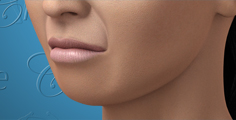
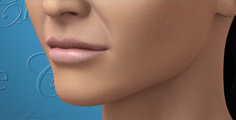
Animated Chin Augmentation
Scroll over the image to see the effects of chin implant on recessed chin.The implant will plump the chin out and fill in the area in front of the jowls.
Improvement of facial aesthetics with chin implant in conjunction with neck lift (no face lift was performed).
3) Upper Lip Wrinkles
Wrinkles around the lip (they can occur below the lip too) are caused by a combination of factors. The most significant are loss of collagen, loss of fat, and the constant motion of the underlying muscles.
The most effective way to improve these wrinkles is dermabrasion with a tiny bit of Botox®. The dermabrasion will smooth and thicken the underlying dermis. Then a very small amount of Botox® will be injected just under the skin to flatten the muscle. This will not affect lip motion but will do a great job of diminishing or eliminating the wrinkles.
Correction of fine wrinkles around the lips with dermabrasion and soft tissue filler.
The overall result may be enhanced with the addition of a conservative soft tissue filler to plump the lips.
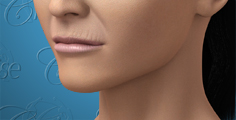
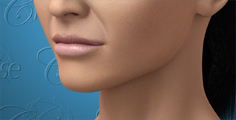
Thin Lips and Upper Lip Wrinkles
Scroll over the image to see the correction
of Thin Lips with Soft Tissue Fillers and
Upper Lip Wrinkles with Dermabrasion
4) Thin Lips
The gold standard for obtaining predictably larger lips with very little down time is Hyaluronic Acid. Soft tissue fillers made with Hyaluronic acid are marketed as
Juvéderm™ , Restylane®, Perlane®, etc. These are a significant improvement over the previous gold standard - collagen. They are touted to last anywhere between 6 to 18 months. In reality, predictable enlargement lasts 6-8 months in the lips.
Correction of thin lips with Juvéderm™ .
Injection techniques have improved considerably. Routinely, Joseph T Cruise, MD will numb up both lips. This ensures that the procedure is done pain free. In addition, Joseph T Cruise, MD uses needles that are half the size normally used. This allows for more accurate placement. In addition, bruising almost never occurs and swelling is minimal. Returning to work the next day is typical.
5) Down Turned Corners of the Mouth
Often, patients complain that they look sad or upset because they have a permanent frown. This is because the corners of their mouth have become down turned with aging. This is most effectively corrected with a face lift. However, there is often a simpler answer - Botox®.
By selectively relaxing the muscles that cause frowning, the corners of the mouth will elevate about 3-4 mm. This simple maneuver, when properly performed, can eliminate the frown and give a happier, more pleasant facial expression. The lips will still work normally and no one will ever know.
Neck Rejuvenation
The Custom Lift® approach to the problem areas of the Neck.
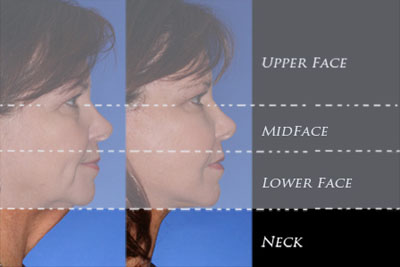
When is a neck lift necessary in addition to the face lift?
There are three major indications for making a chin incision and operating directly on the neck as part of the CustomLift. Lets go through each one.
1) Prominent Neck Bands
These are the cords often referred to as "Turkey Gobbler." They represent the midline border of the Platysma muscle. The only way to predictably correct these bands is to remove and suture the neck muscles together in the midline. This removes the cords and creates a smooth contour with a defined neck angle.
Correction of neck bands (turkey gobbler) is best achieved with direct excision of cords and muscle tightening.
2) Poor Definition of Neck Angle
People with poor definition of their neck angle have a neck that essentially goes right from their chin to their upper chest. Many jokingly say that they have, "no neck."


Animated Neck Lift
Scroll over the image to see the correction of Neck Bands and Loose Skin on the Neck.
The key to the Custom Lift® is to define what is causing the heavy, undefined neck. Often it is a combination of excess fat and hanging platysma muscle. The best way to address this problem is to start with liposuction of the midline neck and jaw line. Then the remaining excess fat and hanging muscle in the midline must be directly removed via the chin incision. The muscle is then tightened in the midline and suspended in an elevated position. This will create a neck angle that did not exist preoperatively.
Example of poor definition of neck angle; corrected by neck lift only.The purpose of the Custom Lift® neck lift is to re-create a youthful neck angle.
3) Heavy Neck
The heavy neck will always have poor definition. This is because the increased mass obliterates the neck angle and gives an undesirable heavy appearance.
A word of caution here. Face and neck lifting is best done on people within 30 lbs of their ideal body weight. Heavier people may have the procedure done but the result will not be as good no matter what technique is used.
The advantage of the Custom Lift® is that it does directly address even the heavy necks and will provide the best result possible. This is especially true when compared to face lifts claiming to be quick with a one-size-fits-all procedure.The technique is similar to that performed for the undefined neck angle but there is considerably more fat removed.
Example of heavy neck with poor neck angle definition corrected by Custom Lift® (Neck Lift with Chin Implant).
Face Lift incisions
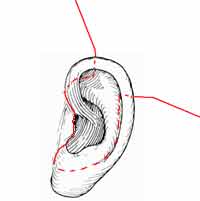
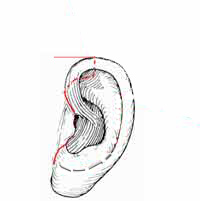
Traditional face lift incision.CustomLift incision. Notice there is no incision behind the ear.

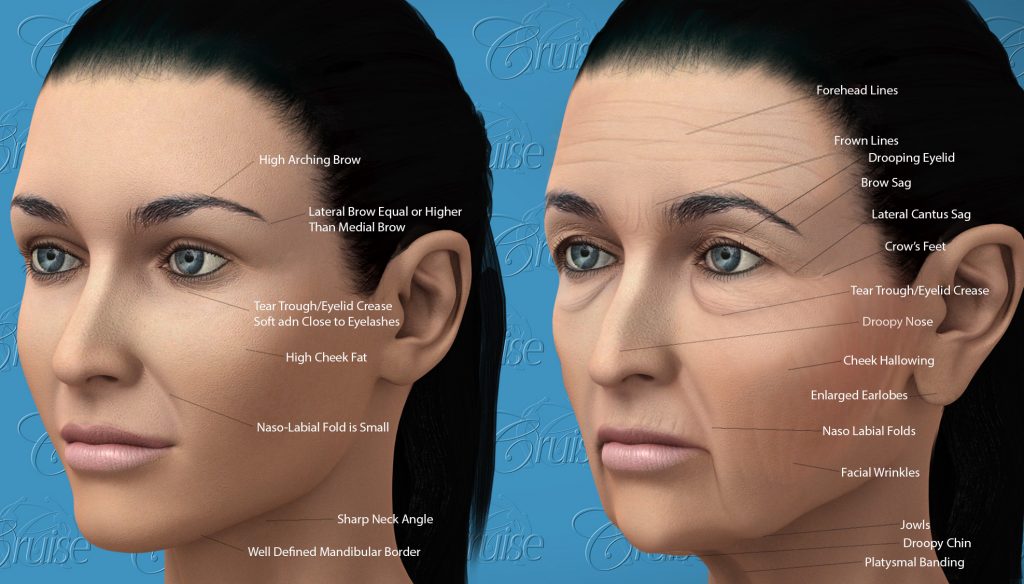
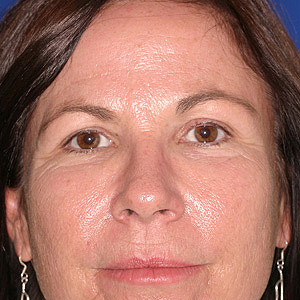
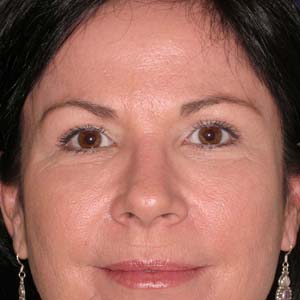
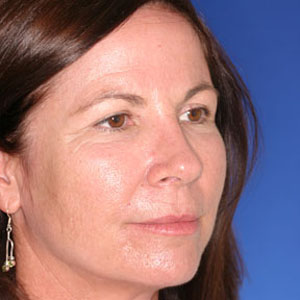
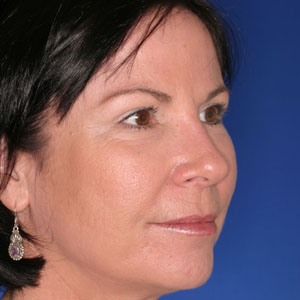
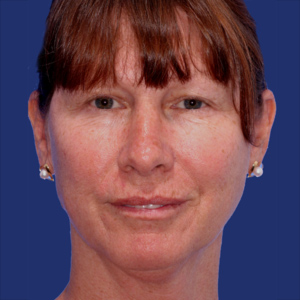
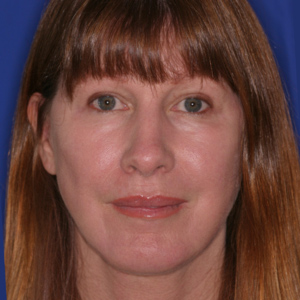
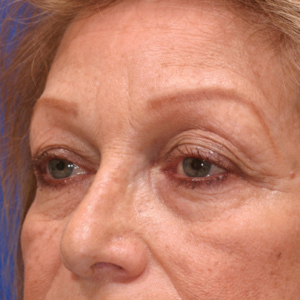
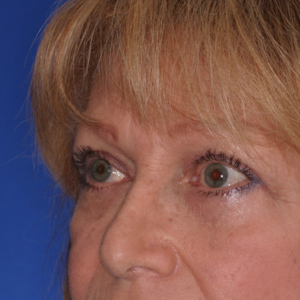
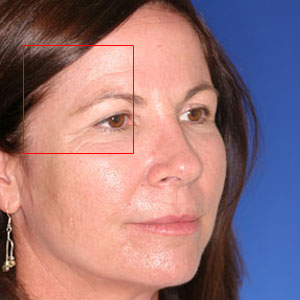
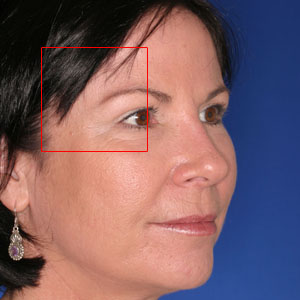
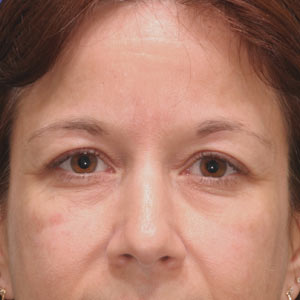
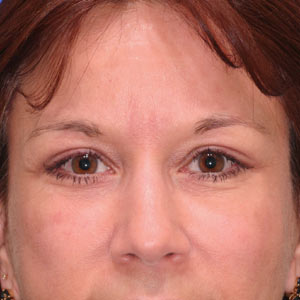
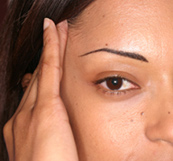
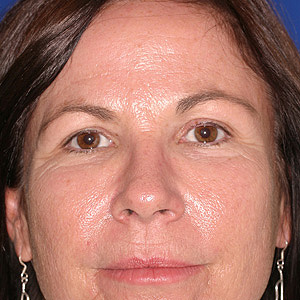
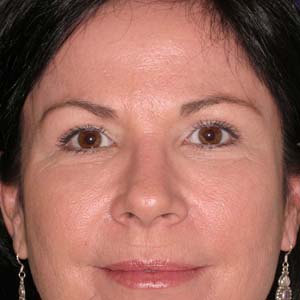
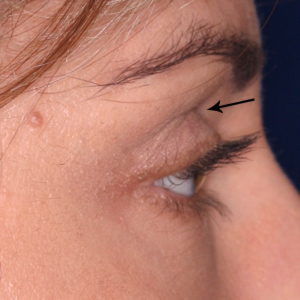
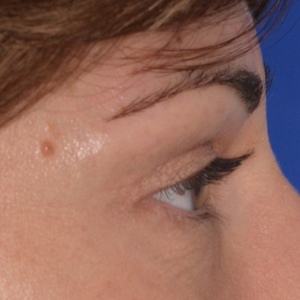



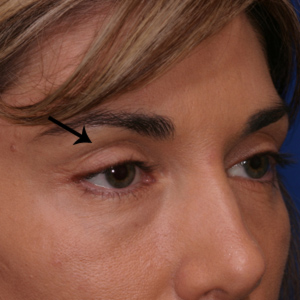
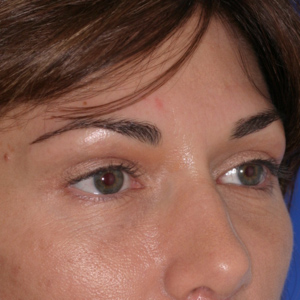
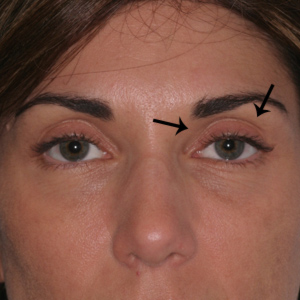
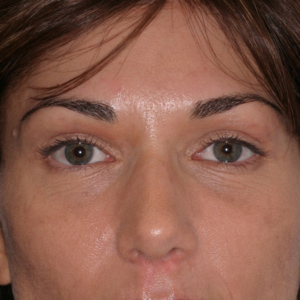
 Wrinkles that are caused by facial expression are best corrected with Botox®. As mentioned earlier, crow's feet that are caused by excess skin are removed by performing a temple lift. Crow's feet that only occur during smiling need Botox®.
Wrinkles that are caused by facial expression are best corrected with Botox®. As mentioned earlier, crow's feet that are caused by excess skin are removed by performing a temple lift. Crow's feet that only occur during smiling need Botox®.